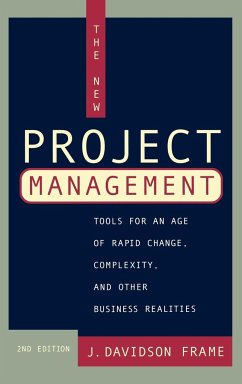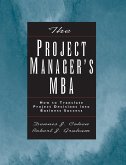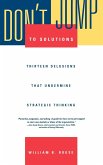J. Davidson Frame
The New Project Management
Tools for an Age of Rapid Change, Complexity, and Other Business Realities
J. Davidson Frame
The New Project Management
Tools for an Age of Rapid Change, Complexity, and Other Business Realities
- Gebundenes Buch
- Merkliste
- Auf die Merkliste
- Bewerten Bewerten
- Teilen
- Produkt teilen
- Produkterinnerung
- Produkterinnerung
In today s business environment, where complexity, chaos, and uncertainty dominate, the old tried-and-true methods of managing projects don t get the job done. In his revision of The New Project Management , J.
Andere Kunden interessierten sich auch für
![The Project Manager's MBA The Project Manager's MBA]() Dennis J. CohenThe Project Manager's MBA55,99 €
Dennis J. CohenThe Project Manager's MBA55,99 €![Managing with the Wisdom of Love Managing with the Wisdom of Love]() Dorothy MarcicManaging with the Wisdom of Love37,99 €
Dorothy MarcicManaging with the Wisdom of Love37,99 €![From The Ground Up From The Ground Up]() Edward E. LawlerFrom The Ground Up28,99 €
Edward E. LawlerFrom The Ground Up28,99 €![Big Change Big Change]() Paul TaffinderBig Change64,99 €
Paul TaffinderBig Change64,99 €![Life and Death in the Executive Fast Lane Life and Death in the Executive Fast Lane]() Manfred F. R. Kets de VriesLife and Death in the Executive Fast Lane41,99 €
Manfred F. R. Kets de VriesLife and Death in the Executive Fast Lane41,99 €![Don't Jump to Solutions Don't Jump to Solutions]() William B. RouseDon't Jump to Solutions42,99 €
William B. RouseDon't Jump to Solutions42,99 €![Champions of Change Champions of Change]() David A. NadlerChampions of Change32,99 €
David A. NadlerChampions of Change32,99 €-
-
-
In today s business environment, where complexity, chaos, and uncertainty dominate, the old tried-and-true methods of managing projects don t get the job done. In his revision of The New Project Management , J.
Produktdetails
- Produktdetails
- Verlag: Wiley & Sons
- 2. Aufl.
- Seitenzahl: 384
- Erscheinungstermin: 22. Mai 2002
- Englisch
- Abmessung: 235mm x 157mm x 27mm
- Gewicht: 646g
- ISBN-13: 9780787958923
- ISBN-10: 0787958921
- Artikelnr.: 10531205
- Herstellerkennzeichnung
- Libri GmbH
- Europaallee 1
- 36244 Bad Hersfeld
- gpsr@libri.de
- Verlag: Wiley & Sons
- 2. Aufl.
- Seitenzahl: 384
- Erscheinungstermin: 22. Mai 2002
- Englisch
- Abmessung: 235mm x 157mm x 27mm
- Gewicht: 646g
- ISBN-13: 9780787958923
- ISBN-10: 0787958921
- Artikelnr.: 10531205
- Herstellerkennzeichnung
- Libri GmbH
- Europaallee 1
- 36244 Bad Hersfeld
- gpsr@libri.de
J. Davidson Frame is Dean of Academic Affairs at the University of Management and Technology (UMT) in Arlington, Virginia. Prior to joining UMT, he established the project management program at George Washington University. He also served as director of the Project Management Certification Program at the Project Management Institute (PMI) and has served on PMI's board of directors. Frame has authored more than forty articles and five books, including Project Management Competence (Jossey-Bass, 1999).
Preface.
The Author.
1. The New Business Environment and the Need for a New Project Management.
Part One: Managing in the New Business Environment.
2. Managing Complexity: Techniques for Fashioning Order out of Chaos.
3. Engaging Change: Knowing When to Embrace, Accept, or Challenge.
4. Managing Risk: Identifying, Analyzing, and Planning Responses.
5. Satisfying Customers: Knowing Who They Are, What They Want, and When
They Are Right or Wrong.
6. Defining Requirements That Bridge the Customer-Developer Gap.
Part Two: Tools for the New Project Management.
7. Acquiring Political Skills and Building Influence.
8. Building Teams with Borrowed Resources.
9. Selecting Projects That Will Lead to Success.
10. Estimating Realistic Costs, Schedules, and Specifications to Ensure
Project Success.
11. Scheduling Projects with New Tools: The Time-Boxed and Critical Chain
Scheduling Techniques.
12. Outsourcing to Control Costs, Focus on Core Work, and Expand Resources.
13. Integrating Cost and Schedule Control to Measure Work Performance.
14. Evaluating Projects to Maintain Goals, Strengthen Accountability, and
Achieve Objectives.
15. Understanding and Using Performance Metrics: Measuring the Right Stuff.
16. Establishing and Maintaining a Project Support Office to Strengthen
Project Management Capabilities.
17. Carpe Diem: Seize the Day!
References.
Index.
The Author.
1. The New Business Environment and the Need for a New Project Management.
Part One: Managing in the New Business Environment.
2. Managing Complexity: Techniques for Fashioning Order out of Chaos.
3. Engaging Change: Knowing When to Embrace, Accept, or Challenge.
4. Managing Risk: Identifying, Analyzing, and Planning Responses.
5. Satisfying Customers: Knowing Who They Are, What They Want, and When
They Are Right or Wrong.
6. Defining Requirements That Bridge the Customer-Developer Gap.
Part Two: Tools for the New Project Management.
7. Acquiring Political Skills and Building Influence.
8. Building Teams with Borrowed Resources.
9. Selecting Projects That Will Lead to Success.
10. Estimating Realistic Costs, Schedules, and Specifications to Ensure
Project Success.
11. Scheduling Projects with New Tools: The Time-Boxed and Critical Chain
Scheduling Techniques.
12. Outsourcing to Control Costs, Focus on Core Work, and Expand Resources.
13. Integrating Cost and Schedule Control to Measure Work Performance.
14. Evaluating Projects to Maintain Goals, Strengthen Accountability, and
Achieve Objectives.
15. Understanding and Using Performance Metrics: Measuring the Right Stuff.
16. Establishing and Maintaining a Project Support Office to Strengthen
Project Management Capabilities.
17. Carpe Diem: Seize the Day!
References.
Index.
Preface.
The Author.
1. The New Business Environment and the Need for a New Project Management.
Part One: Managing in the New Business Environment.
2. Managing Complexity: Techniques for Fashioning Order out of Chaos.
3. Engaging Change: Knowing When to Embrace, Accept, or Challenge.
4. Managing Risk: Identifying, Analyzing, and Planning Responses.
5. Satisfying Customers: Knowing Who They Are, What They Want, and When
They Are Right or Wrong.
6. Defining Requirements That Bridge the Customer-Developer Gap.
Part Two: Tools for the New Project Management.
7. Acquiring Political Skills and Building Influence.
8. Building Teams with Borrowed Resources.
9. Selecting Projects That Will Lead to Success.
10. Estimating Realistic Costs, Schedules, and Specifications to Ensure
Project Success.
11. Scheduling Projects with New Tools: The Time-Boxed and Critical Chain
Scheduling Techniques.
12. Outsourcing to Control Costs, Focus on Core Work, and Expand Resources.
13. Integrating Cost and Schedule Control to Measure Work Performance.
14. Evaluating Projects to Maintain Goals, Strengthen Accountability, and
Achieve Objectives.
15. Understanding and Using Performance Metrics: Measuring the Right Stuff.
16. Establishing and Maintaining a Project Support Office to Strengthen
Project Management Capabilities.
17. Carpe Diem: Seize the Day!
References.
Index.
The Author.
1. The New Business Environment and the Need for a New Project Management.
Part One: Managing in the New Business Environment.
2. Managing Complexity: Techniques for Fashioning Order out of Chaos.
3. Engaging Change: Knowing When to Embrace, Accept, or Challenge.
4. Managing Risk: Identifying, Analyzing, and Planning Responses.
5. Satisfying Customers: Knowing Who They Are, What They Want, and When
They Are Right or Wrong.
6. Defining Requirements That Bridge the Customer-Developer Gap.
Part Two: Tools for the New Project Management.
7. Acquiring Political Skills and Building Influence.
8. Building Teams with Borrowed Resources.
9. Selecting Projects That Will Lead to Success.
10. Estimating Realistic Costs, Schedules, and Specifications to Ensure
Project Success.
11. Scheduling Projects with New Tools: The Time-Boxed and Critical Chain
Scheduling Techniques.
12. Outsourcing to Control Costs, Focus on Core Work, and Expand Resources.
13. Integrating Cost and Schedule Control to Measure Work Performance.
14. Evaluating Projects to Maintain Goals, Strengthen Accountability, and
Achieve Objectives.
15. Understanding and Using Performance Metrics: Measuring the Right Stuff.
16. Establishing and Maintaining a Project Support Office to Strengthen
Project Management Capabilities.
17. Carpe Diem: Seize the Day!
References.
Index.









